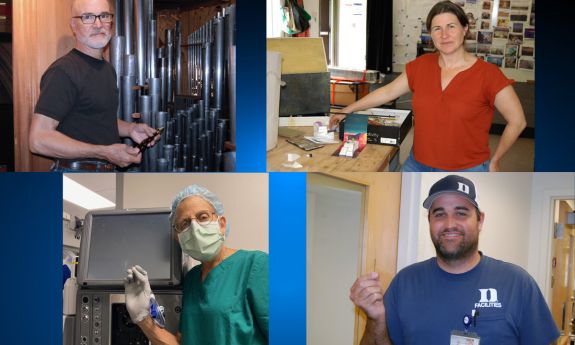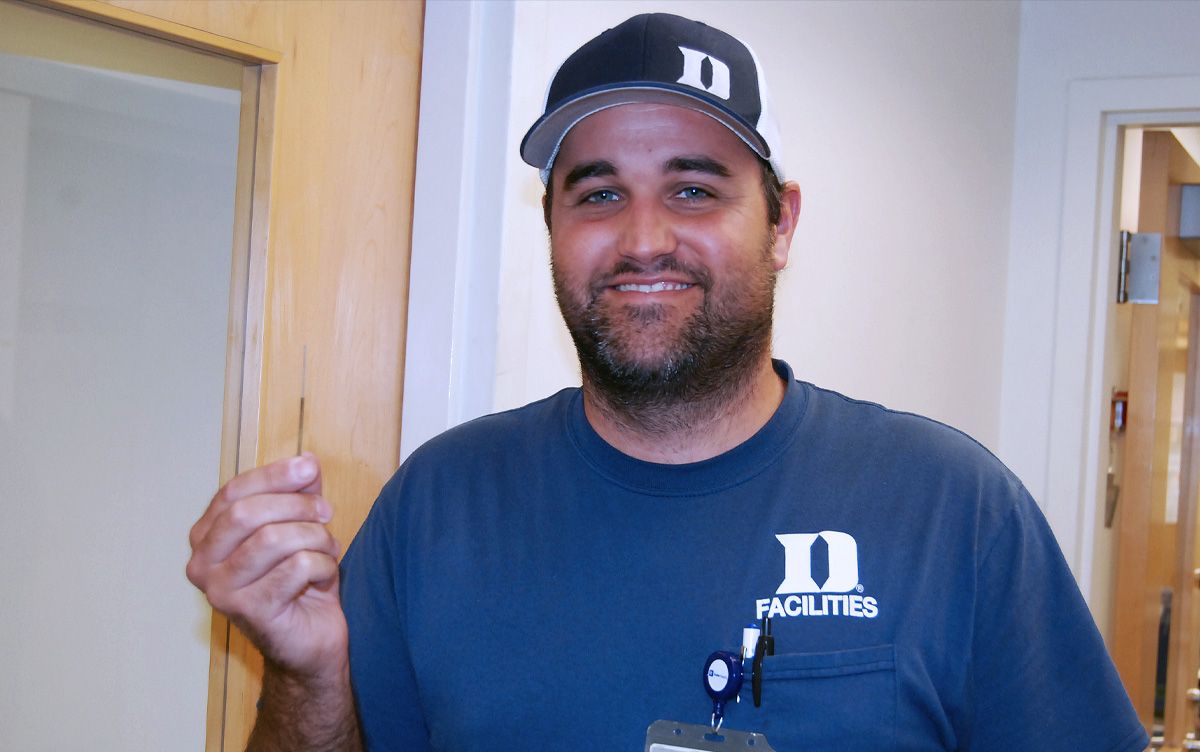The Magical Role of Duke's Tiny Tools
Small instruments serve a vital function in the work of staff and faculty

Tiny Yet Mighty

About half the size of a nail file and resembling a miniature saw blade, a slender key retractor takes up little space in the toolbox of the eight licensed locksmiths in the Duke Key and Lock Shop.
The metal tool that’s an inch or so long has an important job to play in the work of the Facilities Management Department unit, helping staff keep approximately 200,000 doors and a million keys across campus in working order.

When keys break off inside locks, stalling access to student rooms, filing cabinets or research in laboratories, the tool is small enough to fit in tight spaces and can carefully fish out parts of the broken brass stuck inside the keyhole.
“You stick this beside the key and twist it and those grooves actually pull the key back out,” said Barry Clark, manager for the Key and Lock Shop.
Though only one part of a pick kit, the tiny tool is essential to the shop’s timely work answering approximately 4,500 annual campus work orders to replace lost keys, change locks, fish out broken keys and maintain doors to keep campus safe, secure and accessible.
“When you walk out of your office and all of the sudden you can’t lock your door, our work has to be done that day,” Clark said. "Keeping people and things secure makes our work really important."
Precision in Sound

Though many have heard the instrument that combines a keyboard and mechanisms to send air through pipes to produce sound, no one knows the thousands of organ pipes inside Duke University Chapel better than John Santoianni.
As the Ethel Sieck Carrabina Curator of Organs and Harpsicords in the Duke Department of Music and curator for Duke Chapel, about half of Santoianni’s job is to ensure the lead and tin alloy pipes housed above the sanctuary of Duke’s crown jewel are in proper tune for services and other events in the Chapel throughout the academic year. The other half is tuning and maintaining eight other organs and seven harpsicords elsewhere on campus used for teaching.
At Duke Chapel, the nature of the building built in the early 1930s means that temperature changes throughout the year can affect the tuning. That means weekly, Santoianni tunes some pipes, making nuanced changes that will impact notes played on the instrument.
“My job is to lower anxiety, so that when an organist goes and plays every note, that it will be adjusted properly,” Santoianni said. “The organist doesn’t have to think about ‘this doesn’t feel right,’ or ‘this doesn’t sound right.’ If you don’t think about me doing my job at all, then I’ve done my job.”
With pipes ranging from 22-feet long in the Flentrop to the smallest that’s half an inch in length, a full set of wide-ranging-sized tuning cones, made of brass and wood, helps him find the right notes.
The smallest tuning cone, about the size of the king chess piece, helps adjust the shape of pipes as little as a faction of a millimeter at a time. This ensures the smallest pipes, like the f-sharp pipe of the Benjamin N. Duke Memorial Organ, a Flentrop installed in 1976, are always producing beautiful music.
“If I didn’t have it, I couldn’t tune,” Santoianni said. “It is essential.”
A Micro Marvel

Operating on children’s eyes, which are 16 millimeters from front to back or about 2/3 the size of adult eyeballs, requires small cuts and attention to detail.

High tech tools make that delicate work possible.
When Pediatric Ophthalmologist Dr. Sharon Freedman steps into an operating room, one tool helps set the stage to perform those surgeries on her patients, addressing diagnoses through procedures like cataract surgery: It’s the 23-gauge vitrector.
The vitrector, a 0.7 millimeter diameter device, is smaller than a standard needle. The tool's precursor was developed by Dr. Robert Machemer in Miami in 1970, eight years before he came to Duke to serve as chairman of the Department of Ophthalmology. Over the 53-years since it was created by Machemer, who retired from Duke in 1998, the tool has become a standard method for accessing the vitreous cavity inside of the eye in many surgeries performed across the globe.
The revolutionary tool has a multitude of uses, featuring a suction function and cutter at the end, and can grab and then cut of tiny pieces of lens or vitreous gel at a rate of up to 10,000 times per minute. . The vitrector enters the eye through a tiny incision, and helps remove vitreous gel — Jell-O like fluid inside the eye that fills the space behind the lens and in front of the retina— so that eye surgeons can better access the parts of the eye that need correcting. The vitrectomy instrument has a separate infusion line that then replaces the removed gel with sterile isotonic fluid and has and has a sensor to ensure pressure remains constant in the eye.
“These tiny, modern vitrectomy instruments allow us to safely remove childhood cataracts and vitreous gel behind them,” Freedman said. “Retina surgeons use them to safely remove vitreous gel in the back of the eye to facilitate retinal detachment repair in both children and adults. It’s a really cool device.”
From Imagination to Reality

In the months leading up to opening night of a play, Torry Bend is at work in her studio on Central Campus.
Bend, Professor of the Practice of Theater Studies, is a puppet artist and scenic designer whose design work has been seen on stages all over the country. And while a director helps ensure words come to life and actors play out the lines, Bend’s role is to coordinate visual imagery of the production, from the colors and design of the props and backdrops to the texture of materials that will eventually be built full scale.
In that task, creating scale models of the production are a key tool that help her fulfill that job — often using other small tools like an X-ACTO knife, paint brushes and paper to design a 3D model of every part of the production.
“In many ways, it’s old school art class stuff,” Bend said.

Ahead of the spring 2022 production of Pedro Calderon de la Barca’s “Life is a Dream,” a Duke Theater Studies production directed by R. Darren Gobert, the William and Sue Gross Professor of Theater Studies, Bend worked with student Ash Jeffers to recreate a ¼ inch wooden model of von der Heyden Studio Theater.
Bend collaborated closely with Gobert to design the stage and props based on the model, which included moveable stairs, purple carpet, and a versatile box. The box served as a jail for one part of the play, later transforming into a mirror and providing hiding spaces for actors.
The scale model proved indispensable in planning the design before constructing the stage. Thanks to the model, the team ironed out details well in advance, ensuring a seamless show from opening night onward. It served as a vital tool over several months to visualize scenes before full-scale construction.
“Models and model pieces are tools to sort of problem solve blocking for the show and potentially what something is going to look like…” Bend said. “For set design, models are definitely an essential part of communicating what the design ideas can be.”
Send story ideas, shout-outs and photographs through our story idea form or write working@duke.edu.
Follow Working@Duke on X (Twitter), Facebook, and Instagram.